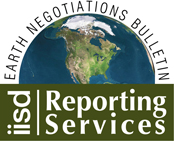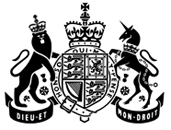 |
||
|
published by IISD, the International Institute for Sustainable Development
in cooperation with the CBD Secretariat |
|||
|
A Special Report on Selected Side Events at CBD COP-8
|
|||||
| 20-31 March 2006 | Curitiba, Brazil | |||||
 |
 |
||||
 |
|||||
|
United Kingdom Foreign & Commonwealth Office
|
|||||
Events convened on Wednesday, 22 March 2006
|
BIOTA AFRICA: Research for conservation and sustainable management of biodiversity in Africa Presented by the German Federal Ministry of Education and Research (BMBF) |
|||
|
Karen Hahn-Hadjali, University of Frankfurt, presented the BIOTA research approach, designed using German and African expertise. Discussing the use of biological observatories in an interdisciplinary comparison of land use practices in a standardized research area, she emphasized that BIOTA aims to understand drivers for change; assess the value of natural resources for local communities, and to develop appropriate action plans. She stressed that it is vital to develop approaches that have short term benefits when identifying strategies for restoration. She gave Burkina Faso as an example of where the traditional planting hole method and deep plowing approaches had both been used successfully. Konaté Souleymane, University of Abobo-Adjame, Côte d’Ivoire, introduced the Zaï system of soil restoration using termites, noting that these are important for ecosystem functioning, soil processes and fertility, and can contribute to carbon sequestration. He explained that agricultural Zaï involves the placement of organic matter in a hole to attract termites and fertilize the soil. He highlighted how this can improve agricultural efficiency, as the termites increase soil porosity and clay content. Wolfgang Küper, University of Bonn, discussed African biodiversity conservation strategies, noting that given species richness patterns, the present extent of protected areas (PAs) could be better allocated to protect biodiversity, but that this is constrained by human settlement patterns. He suggested the need for a two-track approach, taking into consideration the irreplaceability of species and the need for sustainable management. Küper then presented BIOTA Africa’s strategy, which stresses the consideration of land use, climate change, community involvement, information dissemination, and transboundary cooperation. Brice Sinsin, IUCN/WCPA, noted that existing coverage of PAs in West Africa is insufficient to protect biodiversity against rising population levels, and that management could be improved by filling knowledge gaps, involving locals, and improving the economic value of PAs. He highlighted that BIOTA contributes to addressing these needs through an integrative, multidisciplinary approach, establishing a biophysical baseline for biodiversity monitoring, capacity building, and addressing socioeconomic aspects through local cooperation. Discussion: Participants discussed the value of considering additional categories of PAs, and the sampling methods that BIOTA uses in its research. |
|||
|
|||
|
World Water Day - Water and Biodiversity: an Ecosystem Perspective for the Brazilian National Water Resources Plan Presented by the Secretariat of Water Resources, Brazilian Ministry of Environment |
|||
|
In presenting the National Water Resource Plan (PNRH), Jose Machado, National Water Agency (ANA), Brazil, stated that this was established in response to recommendations made at UNCED +10 in 2002, and aims to achieve the Millennium Development Goals related to water. Marley Caetano de Mendonça, Brazilian Ministry of Environment, described the milestones leading to the preparation of the PNRH, noting that world scenarios (2005-2020) were built to provide guidance for future potential policy alternatives for the Brazilian water resources system, including three potential scenarios such as “water for all” with strong social inclusion, “water for some” with average favorable conditions, and “water for few” with unfavorable social conditions. Rita Cerqueira Ribeiro de Souza, Brazilian Ministry of Environment, spoke on the work carried out to identify the Brazilian Aquatic Ecoregions, which endeavors to improve the understanding of freshwater biodiversity in Latin America. De Souza noted that 25 aquatic regions were identified and included in the PNRH, with the selection of five priority ecoregions including the Xingu-Tapajós, Pantanal, Iguaçu Falls, Southeast Coast, and Atlantic Forest. Victor Sucupira, ANA, presented the worldwide availability of water versus consumption per habitant, and the diverse status of water availability and quality for each region in Brazil. Sucupira highlighted challenges faced in the management of water resources in Brazil, noting that while the Northern region has greater availability of water and few people, the Northeast faces water scarcity and rampant poverty, while the Southeastern region suffers from higher pollution levels due to industrialization. |
|||
Rita Cerqueira Ribeiro de Souza, Brazilian Ministry of Environment, presented the work done in the identification of 25 aquatic regions in Brazil, which is available for participants in a CD-Rom
|
|||
|
Financial Mechanisms for Protected Areas Presented by the Amazon Region Protected Areas (ARPA) Project and the Brazilian Fund for Biodiversity (Funbio) |
||
|
Pedro Leitão, Funbio, explained that ARPA’s goal is to protect 12% of the Amazon region, 50% as strict protected areas (PA) and 50% as sustainable use PA, one of its challenges being to conceive and develop sustainable financial mechanisms.
Fábio Leite, Funbio, said that following completion of their initial study of potential funding sources, Funbio will implement pilot projects to test alternative sources. He discussed examples such as payments for watershed protection and biodiversity offsets. Joshua Bishop, IUCN, spoke on new and additional funding sources, saying the key is to consider how to transform natural resources into resources from a business point of view, to understand private investment drivers and to build on existing markets. Outlining the activities of the Latin American and the Caribbean Network of Environmental Funds (RedLAC), Alberto Paniagua, Peruvian Trust Fund for National Parks and Protected Areas (PROFONANPE) noted that public fund participation in funding PAs is very weak. On payments for ecosystem services, Carlos Eduardo Young, Federal University Rio de Janeiro, proposed they are more likely to occur where ecosystem services or goods are relatively rare or threatened and where opportunity costs for implementing and maintaining environmentally sound practices are scarce. Discussion: Participants discussed current concerns being expressed about payments for ecosystems services in some developing countries such as their possible equity impacts. |
||
|
|||
|
|||
|
New Developments in the International Pollinator Initiative Presented by the Governments of Brazil, the United States and South Africa |
||
|
Connal Eardley, Agricultural Research Council - Plant Protection Research Institute (ARC LNR) presented the results of a workshop in South Africa on pollinators and pollination, which are being published in a new book titled "Pollinators and Pollination: A resource book for policy and practice." He welcomed the reaching of the African Pollinator Initiative's original goal of including African countries in the UNEP-GEF project saying the Initiative's current projects include plant pollinator surveys, bee identification courses and biodiversity studies.
Linda Collette, UN Food and Agriculture Organization (FAO), said that as coordinator of the International Pollinator Initiative on the Conservation and Management of Pollinators, FAO is preparing a UNEP-GEF project aimed at promoting sustainable agriculture through an ecosystem approach which is imminently expecting the GEF green light. Bráulio de Souza Dias, Brazilian Ministry of Environment, emphasized the importance of mobilising resources and generating broad interest to implement the Brazilian Pollinators Initiative, which now has more that 50 institutions involved and more than US$7 million committed. Providing an outline of the North American Pollinator Initiative and the North American Pollinator Protection Campaign (NAPPC), Toral Patel-Weynand, USGS, said that NAPPC's activities include a National Academy Study which will be published in 2006 with recommendations for research, monitoring, conservation and restoration, and identification of gaps. Discussion: One participant said an issue attracting attention to pollinators has been their possible implications for GM crop transfer and biosafety. Ivan Valdespino, Inter-American Biodiversity Information Network (Iabin) and Jim Edwards, Global Biodiversity Information Facility (GBIF), spoke of initiatives in information sharing and knowledge development. |
||
|
|||
|
|
||
|
||
|
Click the above button to go back to our ENB main coverage
|
||
|
|
|
|
|
||
|

















